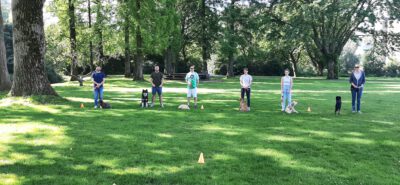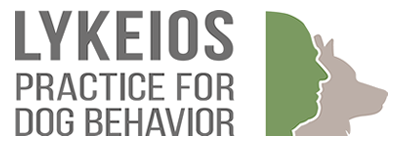
Group training - A dog full of attention for its owner
In this training of one session a week owners learn to establish a stable relationship with their dog through a number of practical exercises.
The basis of this training is the paying attention exercise. Actually this is much more than just a exercise, It is the only way we ought to walk with our dog at the leash.
In addition, the owners learn the most important obedience ecxercises: to follow, to sit and wait, to lie down and stay en finally to come here. Besides the dog is trained to retrieve an object and to be sent to its place from a distance. Finally we practice the jogging and cycling with our dog. The principles of the learning theories of Pavlov and Skinner are taken as a starting point when teaching desired behaviour in the dogs.
An average of eigth dogs participate in the training. The objective, however, is always to ensure that every dog keeps its attention fully focused on its owner and that he knows how to claim his dog's attention in all kinds of situations.
We are training once a week with the whole group on Saturday. In between the owners are following an exercise programme at home with their dog. The training concludes with an exam.
Afterwards we can truly see our dogs having complete attention for their owners and performing the exercises with a lot of fun!
This training will be offered twice a year, in spring and in autumn.
Obedience exercises
- Attention exercises on the two-meter leash
- Attention test on the long leashof approximately six meters
- Conditioned reinforcer YES
- Exercise FOLLOW with shortened leash, the dog walks on the left side next to its owner
- Exercise SIT, the dog sits down on a given signal during following
- Exercise SIT, the dog remains seated for a longer time
- Exercise DOWN, after he has sat down, the dog lies down on a given signal
- Exercise DOWN, dog remains lying down longer
- Exercise DOWN/STAY, the owner gives a signal and walks away when the dog is lying down. The dog remains lying down even when the owner returns, only on a sign of reinforcement the dog is allowed to get up
- Exercise SIT/HOLD, the owner gives the dog a signal and walks away when the dog is sitting. The owner decides whether to cut or drop the leash. The dog remains seated even when the owner returns, only when the owner gives a reoinforcement signal, the dog is allowed to get up
- Exercise COME, the owner calls his dog with a signal from a distance.He makes the dog sit in front of him and fixes the leash.
Extra exercises

- Exercise PLACE, the dog is sent to a remote dog mat and lies down there
- Exercise RETRIEVE, the owner throws an object while the dog remains seated, then the owner signals his dog and the dog retrieves the object, sits down in front of his owner and releases the object.
Organisation and working methods
- The group consists of six to eight owners and their dogs
- The training takes place on Saturdays at the Beatrixpark
- Required tools
- Two-meter leash with loop and musketon hook
- Slip chain or slip band
- Long leash of six meters
- Dog treat
- The training consists of ten lessons of 60 minutes once a week
- At home in between the lessons the owners follow independently a homework program
- The costs for a single session amount € 25,00, for ten sessions € 200,00.
Objectives
Pay Attention exercises at the two-meter leash
- The owner is able of walking through other dogs, leading his own dog at a not shortened two-meter leash, which he is holding properly, without talking to his dog or sending out any other signals to him.
- He knows how to draw his dog’s attention and to keep it, by walking in straight lines with an upright posture and by changing direction at the right time.
- He may be able to correct his dog at the right time and in the right way.
Pay Attention test at the long leash
- The owner is able of testing his dog’s attention at a long leash of approximately six meters by walking away in time, if possible, by increasing the pace.
- He may be able to correct his dog at the right time and in the right way.
Conditioned reinforcement YES
- The owner is able of conditioning his dog properly on the positive reinforcement YES
Exercise FOLLOW
- The owner is able of shortening the two-meter leash properly in preparation for the exercise FOLLOW
- He is able of starting the exercise FOLLOW properly by getting away with his left leg and simultaneously giving the signal FOLLOW and next, when the dog is walking to his left, he knows how to reinforce this behavior with the conditioned reinforcement YES at the right time.
- He is able of determining the right moment when he has to change directions, both clockwise or counterclockwise and clockwise or counterclockwise rotation.
- He knows how to determine the right moment when he has to accelerate or to slow down.
- He may be able to correct his dog at the right time and in the right way.
Exercise SIT
- The owner is able of performing the exercise SIT properly by giving the signal SIT if possible, accompanied by an act to make the dog sit down.
- He is able to make the dog sit longer by applying the reinforcement YES properly.
- He may be able to correct his dog at the right time and in the right way.
Exercise DOWN
- The owner is able of performing the exercise DOWN properly by giving the signal DOWN if possible, accompanied by an act to make the dog lie down.
- He is able to make the dog lie down longer by applying the reinforcement YES properly.
- He may be able to correct his dog at the right time and in the right way.
Exercise DOWN/STAY
- The owner is able of performing the exercise STAY properly by giving the signal STAY the moment his dog is lying down, accompanied by a stop sign with his hand.
- He knows how far he can walk away from his dog and when he has to return towards him.
- He is able to end the exercise properly by applying the reinforcement YES.
Exercise SIT/HOLD
- The owner is able of performing the exercise WAIT properly by giving the signal WAIT the moment his dog is sitting, accompanied by a stop sign with his hand.
- He is able to estimate whether to cut the leash loose or to drop it.
- He knows how far he can walk away from his dog and when he has to return towards him.
- He is able to end the exercise properly by applying the reinforcement YES.
Exercise COME
- The owner is able of performing the exercise COME properly by first making the dog sit and wait and next by walking away and from a distance calling his dog giving the signal COME.
- He is able to estimate whether the dog needs to be stimulated during coming towards him or his enthusiasm needs to be limited.
- He is able to give the signal SIT at the right moment in order to make the dog sit right in front of him.
- He is able to end the exercise properly by applying the reinforcement YES.
Exercise Place
- The owner is able to perform the exercise PLACE properly by first sending his dog to a dog mat at a certain distance with the signal PLACE and next by making his dog lie down with the signal DOWN
- He is able to end the exercise properly by applying the positive reinforcement-clicker.
Exercise Retrieve
- The owner is able to perform the exercise RETRIEVE properly by first making his dog sit and making him wait while he is throwing away an object, and next by making his dog retrieve the object with the signal RETRIEVE and letting it go when he sits in front of him.
- He is able to end the exercise properly by applying the positive reinforcement-clicker.
Who am I

Joep de Keyzer
- Licensed dog behavioral therapist
- Experienced teacher and coach
- Expert in the field of behavioral science and the dog’s natural behavior
Contact
Having become curious? Having any questions? Or like to make an appointment? Please contact me!
Dog behavioral Practice Lykeios
- Peeskesweg 2, 7041 CB 's Heerenberg
- 06-23914292
- info@lykeios.nl
Vetenerian Clinic de Pijp
- Ceintuurbaan 199, 1074 CV Amsterdam
- 020-26119548
- info@dierenkliniekdepijp.nl
